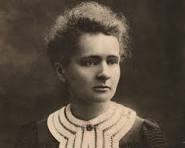|
|
|

DOUBLE NOBEL LAUREATE MARIA CURIE  | Simo Jelača | |
| |
detail from: KRK Art dizajn
DOUBLE NOBEL LAUREATE - MARIA CURIE
SIMO JELAČA, Ph.D.
Marie Curie, scientific genius, woman, simply unstoppable in everything she wanted. She had her own story acquired at an early age: "Never allow yourself to be defeated by anything or anyone."

Polish woman, born in Warsaw in 1867, in the Skladowski family (Wladislav & Bronislawa Skladowski), both parents teachers in high school. Maria graduated from high school in Warsaw with excellent results. She always wanted to study physics and mathematics at the Sorbonne University in Paris. Her mother Bronislava, as an outstanding personality, distinguished by her moral authority, raised five children and passed on highly human personality traits to them.Maria went to Paris with her older sister, where they both worked for four years as governesses and saved money for Maia's studies. Maria was admitted to the Sorbonne in 1891, and among the 1825 students there were only 23 women. When she finished her studies in 1894, she intended to return to Warsaw, but Pierre Curie, who was 35 years old at the time, intervened in her life. Pierre was working with his brother at that time and the two of them realized the "Piezoelectric effect", and when he met Maria, the two started working together from then on. They got married in 1895.The German physicist Roentgen (Wilhelm Rontgen) worked then with x-rays, otherwise Tesla's invention, establishing that x-rays act like light, penetrate tissues and act on a photographic plate. Marie Curie became interested in that and decided to do her doctoral dissertation in that field. She worked with uranium and found that uranium oxide was even more reactive than pure uranium. She found its purest component, which she named Radium. She determined that Radium is also found in nature as pure, only in very small amounts, even only a fraction of a gram in a ton of ore.Maria gave birth to a daughter, Irene, in 1897, and a second daughter, Eva, in 1904. She and her husband Pierre worked very hard, so they had no time for colleagues, friends and relatives.Radium, which Maria discovered and the two of them worked with, was radioactive beyond all expectations. When Maria defended her doctoral dissertation in 1903, she and Pierre received the Nobel Prize, the same year, in physics, for the discovery of Radium. Then Ernest Rutherford, to congratulate them. Thus, Maria became the first woman in the world to win the Nobel Prize. Pierre was soon invited to London, where he gave lectures on their discovery, for which Humphry Davy presented him with an award for the greatest contribution to science in that year.Radium rays were found to be very active and destroy tissues, causing deep burns. Maria and Pierre, as the first researchers of the same, were just getting their first experiences about it and did not protect themselves enough from that radiation, so they were both irradiated. In Maria, it was first identified as anemia, and Pierre's bones hurt, which the doctor labeled as rheumatism. Maria could not work for two years (1911-1913). Pierre died at the age of 47, and Maria suffered a lot after him and had to work again and take care of her daughters.Marie Curie received the second Nobel Prize in 1911, this time in chemistry, for the tested properties of radium and the discovery of polonium. With that, she became the first winner of two Nobel Prizes in the world and the only woman in the world. After Pierre's death, Maria was chosen as a full professor at the Sorbonne, instead of Pierre.And when World War I began, many doctors began to study radiology, using x-rays for diagnosis and treatment. Maria helped them wholeheartedly. She soon made a mobile device for use at the front, and when it was known that it worked well, she also made a mobile ambulance with these devices, which began to be widely used. Then about twenty such mobile ambulances were built, and later even hundreds. Maria's daughter Irena also worked at the front, as a nurse. She also studied at the Sorbonne and completed physics, mathematics and chemistry. And after her studies, she worked with her mother, with x-rays, as her first assistant. After the war, Maria and Irena worked at the Radium Institute at the Sorbonne. That institute was dedicated to Pierre Curie and had a laboratory for radiology. Maria’s daughter Irene Joliot-Curie got her Ph.D. 1925, worked with her husband Frederic Joliot, and received Nobel prizes in chemistry 1935, sharing it with her husband Frederic. They had worked on natural and artificial radioactivity, transmutation of elements, and nuclear physics. Later, our professor Dr. Pavle Savić worked with Irena, and the two of them missed out on the Nobel Prize by only one vote.Towards the end of her working career, Marie Curie grew flowers at the Sorbonne, where she was declared a legend. The Radium Institute became very famous around the world during the 1920s and 1930s. Maria's health deteriorated and she died in 1934. Her name is certainly inscribed among the world's famous scientific giants, and she also serves as a benchmark for comparing the achievements of other scientists. We Serbs can add to the name Marie Curie and have our own Mileva Marić-Einstein. Just before the end of Maria's life, she was given a reception at the White House in Washington, where President Harding organized a ceremony for her.
|

















